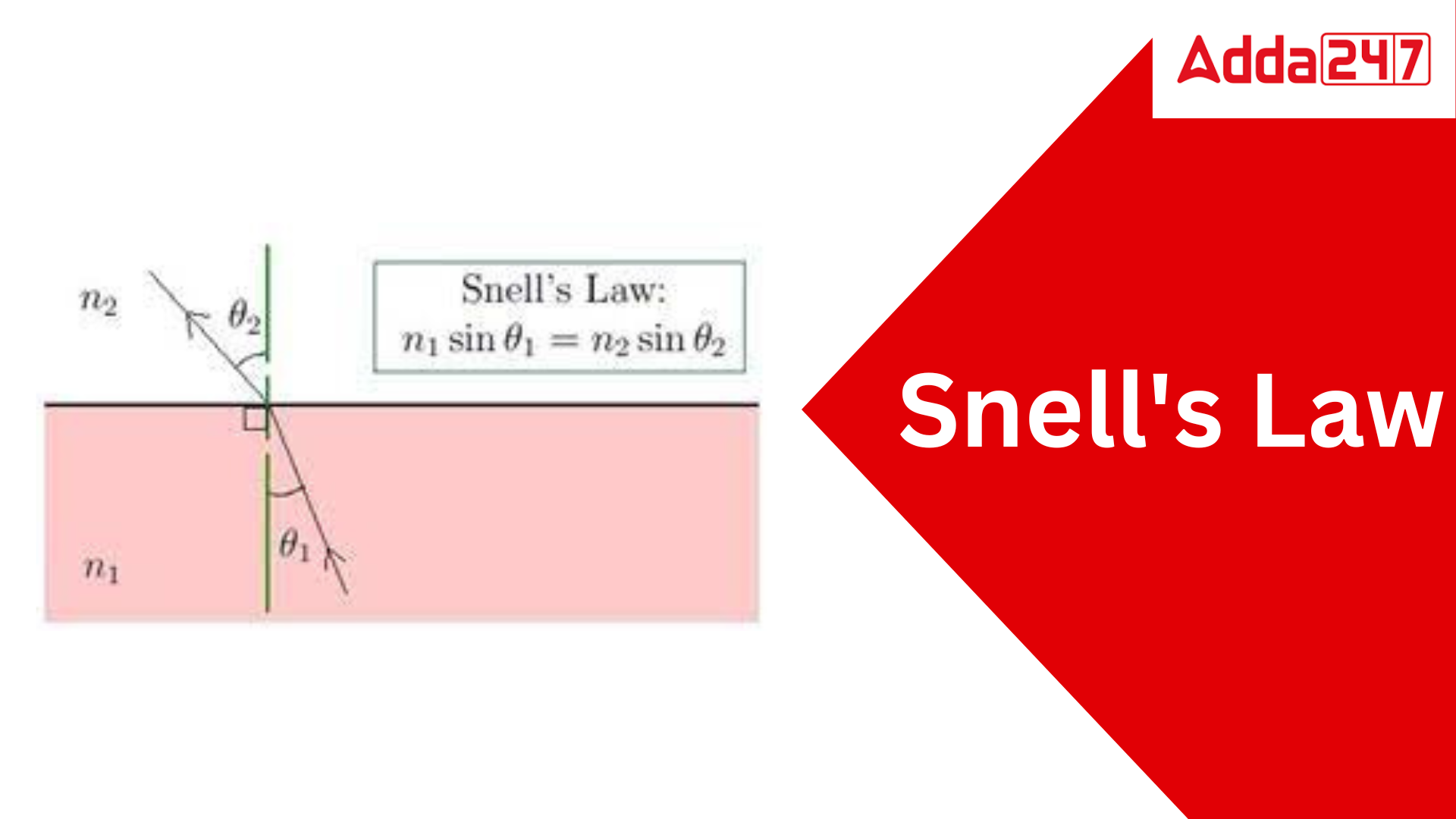Snell’s law: Snell’s law, commonly known as the law of refraction, is a physical law that defines how light bends when it passes from one medium to another. According to the law, the ratio of the sine of the angle of incidence to the sine of the angle of refraction equals the ratio of the refractive indices of the two media.In other words, if a beam of light strikes a border between two media, the angle of refraction will be smaller than the angle of incidence if the second medium has a higher refractive index than the first. The contrary is also true: if the second medium has a lower refractive index than the first, the angle of refraction will be greater than the angle of incidence.Snell’s law is a fundamental optical law that is utilised in a range of applications, including the design of lenses, prisms, and optical instruments.
Snell’s law Definition
The angle that the incident ray makes with the refracted ray, as well as the normal line that is dropped on the plane perpendicularly, are used to calculate the point of refraction. Unlike reflection, the medium through which light rays pass makes a significant effect on refraction. Snell’s Law’s medium dependence is highlighted by the refractive indices.

The surface normal is used to calculate the angles created by the refracted beam at the contact point.
The two different media that will influence the refraction are n1 and n2.Water has a refractive index of 1.33, while air has a refractive index of 1.00029.Consider the light of wavelength 600 nm that passes from water into air to better comprehend Snell’s Law.To determine the angle formed by the outgoing beam, we use the figures in the above-mentioned formula.
1.33 sin 30o = 1.00029 sin x
x = 41o
Snell’s law Formula
Following is the formula of Snell’s law.
n1 sin θ1 = n2 sin θ2.
Snell’s law Derivation
Snell’s law can be derived from the wave nature of light. When a wave encounters a boundary between two media, the wave will change direction, or refract. This is because the wave travels at different speeds in the two media.
The speed of a wave is given by the following equation:
v = f λ
Where:
v is the speed of the wave
f is the frequency of the wave
λ is the wavelength of the wave
When a wave encounters a boundary between two media, the speed of the wave changes. The equation for the speed of a wave in a medium is given by the following equation:
v = n λ
Where:
n is the refractive index of the medium
λ is the wavelength of the wave in the medium
The refractive index of a medium is a measure of how much the speed of light is slowed down in the medium. The higher the refractive index, the slower the light travels in the medium.
The angle of refraction can be calculated using the following equation:
θ = sin^-1 (v1 sin θ1 / v2)
Where:
θ is the angle of refraction
v1 is the speed of the wave in the first medium
v2 is the speed of the wave in the second medium
θ1 is the angle of incidence
Snell’s law can be derived from this equation by substituting the equations for the speed of the wave in each medium.
The following steps can be used to derive Snell’s law:
Start with the equation for the speed of a wave in a medium:
v = n λ
Substitute the speed of light in a vacuum for the speed of the wave in the first medium:
v1 = c = λ1 f
Substitute the speed of light in a vacuum for the speed of the wave in the second medium:
v2 = c = λ2 f
Substitute these equations into the equation for the angle of refraction:
θ = sin^-1 (v1 sin θ1 / v2)
Simplify the equation by canceling the common factors:
θ = sin^-1 (λ1 sin θ1 / λ2)
Finally, replace the wavelength of the wave in each medium with the following equation:
λ = v / f
This gives the following equation for the angle of refraction:
θ = sin^-1 (v1 sin θ1 / v2 sin θ2)
Snell’s law in Hindi
स्नेल का नियम (Snell’s Law) विकिरण विज्ञान में एक महत्वपूर्ण नियम है जो प्रतिदीप्ति व अपवर्तन के दृष्टिकोणों के बीच संबंध स्थापित करता है। इसे विकिरण नियम भी कहते हैं। यह नियम रेफ्रैक्शन के समय का निर्धारण करता है, जिसके आधार पर एक प्रकार के माध्यम से दूसरे माध्यम में रोन्दी विकिरण होता है।स्नेल का नियम का सिद्धांत यह है कि जब किसी विकिरणीय माध्यम के सतह पर एक अन्य माध्यम से विकिरण होता है, तो दोनों माध्यमों में विकिरण वेगों का अनुपात नियमित होता है। यह नियम आँखों से उत्पन्न दिखती हुई झलकों, उड़ाने वाली वस्तुओं और तरंगों के प्रकाशीय रुपों के साथ संबंधित होता है।इसे माथमेटिकल रूप में लिखा जा सकता है: यदि किसी माध्यम में प्रकाशीय रेखीय आँख अन्य माध्यम में प्रकाशीय रेखीय आँख में विकिरण होता है, तो दोनों माध्यमों के बीच विकिरण दोनों सीधे रेखाओं के बीच तिगुना होता है और यह अंतर दोनों के अलग-अलग सतहों पर अभिवृद्धि के साथ बदलता है।स्नेल का नियम दरअसल विकिरण के प्रकाश के लिए विभिन्न माध्यमों की आँछ में बुद्धि का सिद्धांत है। इसे नोर्मन रॉबर्ट फिजे ने 17वीं शताब्दी में पहली बार प्रस्तुत किया था। स्नेल का नियम प्रकाश विकिरण को समझने और विभिन्न माध्यमों में उसका रवैया समझने में महत्वपूर्ण भूमिका निभाता है।









 CUET 2026 Free Batches Launched by CUET ...
CUET 2026 Free Batches Launched by CUET ...
 CBSE Date Sheet 2026 for Class 10 & ...
CBSE Date Sheet 2026 for Class 10 & ...
 CBSE Class 10 Date Sheet 2026, Check 10t...
CBSE Class 10 Date Sheet 2026, Check 10t...














